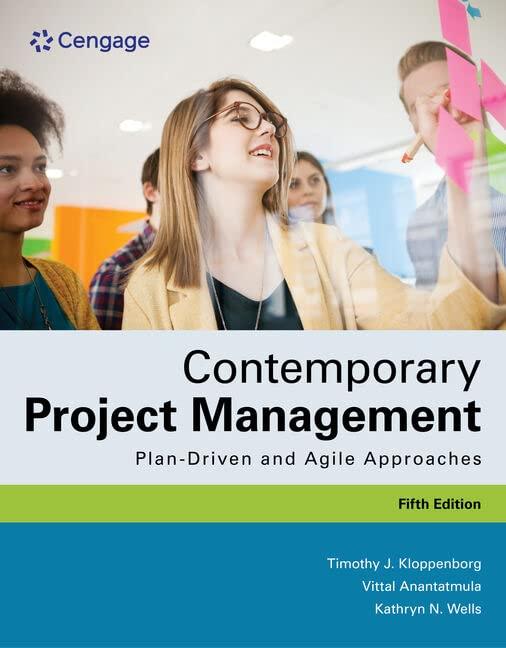When this project was envisioned, it was possible to state a vision for the outcomes, but way
Question:
When this project was envisioned, it was possible to state a vision for the outcomes, but way too premature to try to describe specific outputs. Therefore, it made sense to use an agile approach. Success from this project is defined as helping the customer achieve their desired outcomes. These outcomes include securing arboreta status so the center could be rented more frequently and for a higher rate along with educating citizens, especially on native plants.
An Agile approach allowed for increased visibility for stakeholders to see the plan implemented a bit at a time and to make adjustments. When certain early plans did not materialize, it allowed for adaptations. An example of this was when the garden tour date was announced for the first year of the arboretum, that date had already been rented out, so the arboretum could not be on the garden tour. Since an educational event is an essential component of arboreta status, plans shifted quickly to hosting local science teachers to encourage them to engage their students and with the state forester to bring in tree commissioners from other jurisdictions to show them how to create an arboretum.
Anderson Township’s organizational structure has three elected Trustees with various departments and volunteer advisory committees. The departments impacted by this project include:
• planning and zoning (for the overall planning and how this fits in the community), • operations (for maintenance), • events (for site rental), and • public works (for protecting greenspace).
The committees offer advice. Each has one Trustee and at least one staff member who works with them. The citizen volunteers on each committee are appointed one year at a time, expected to attend bi-monthly meetings, encouraged to help further, and may reapply for future years. The committees impacted include:
• Tree (to promote appropriate tree planting and maintenance), • Greenspace (to perpetually retain designated greenspace in its natural state), and • WeTHRIVE! Anderson (to promote beauty, clean-up, and health).
The Agile life cycle of this project started with the equivalent of a charter by the Trustees giving permission to apply for arboretum status. Arboretum status was granted based upon agreement to develop plans, maintain the facility, and use it for educational purposes. While the master plan was being developed, enthusiastic volunteers opportunistically planted some trees. It was determined that future plantings would only be accepted if they fit with the master plan. The master plan includes a vision statement, site conditions, design concept, both current and planned site maps, and recommendations specifically identified for the first year and generally identified for some time in the next four years. This master plan was iteratively developed by a few members of the Tree Committee with as much input as was possible to acquire from staff and other committees. It was presented to the Tree Committee, then the Trustees, then at the Trustees annual planning meeting with all managers from Township staff. This development and presenting of the master plan effectively shared the vision, helping to transition from initiation to planning and implantation. This master plan serves as a general roadmap for the next four or five years and specific plans for short-term development will be developed from it.
Other Agile concepts are being used on this project. One is to demonstrate a proven approach. The site map and concept included a “buffer zone” to transition from lawn into woods. Even though all stakeholders saw that, it was not until flags were placed to show exact planting spots for trees and shrubs that some stakeholders envisioned exactly what was planned and then objected. The sites for the plantings were moved and the number of plantings were reduced in response. Further, some stakeholders have said to possibly wait a year for more planting to see how this looks and how maintenance is impacted. This is an example of operating in an experiment-based manner. Progress and plans are reported every two months to the Tree Committee and every year to the Trustees.
One key question is how roles should be defined and who should fill each role. As the project started, the Greenspace Inspector took the active role from the Township side, acting as product owner. This person, however, did not have the full authority to also act as sponsor. Some of the other impacted staff functions provided active input and others did not. One Tree Committee member acted as scrum master. However, due to the pandemic and cold winter weather, meeting in person was very difficult. Since many people involved are volunteers, scheduling virtual meetings and even securing timely feedback was sometimes difficult. All projects meet challenges, and rather than use them as excuses, methods needed to be developed to overcome them. On this project, there were more informal meetings and calls and texts between two or three people rather than larger teams.
Questions for Students:
1. How can planning and implementation of this project be simplified?
2. Define roles and expectations for each role.
3. How would you get all stakeholders to work together if you were the scrum master?
4. What do you feel is a sustainable pace for this project and why?
5. How can team members effectively utilize the following Agile principles to advance these projects?
• Accept simplicity • Embrace change • Maximize value • Provide and respond to rapid feedback
Step by Step Answer:

Contemporary Project Management
ISBN: 9780357715734
5th Edition
Authors: Timothy Kloppenborg, Vittal S. Anantatmula, Kathryn Wells





